Crew 27 – Assigned 753rd Squadron – October 14, 1943
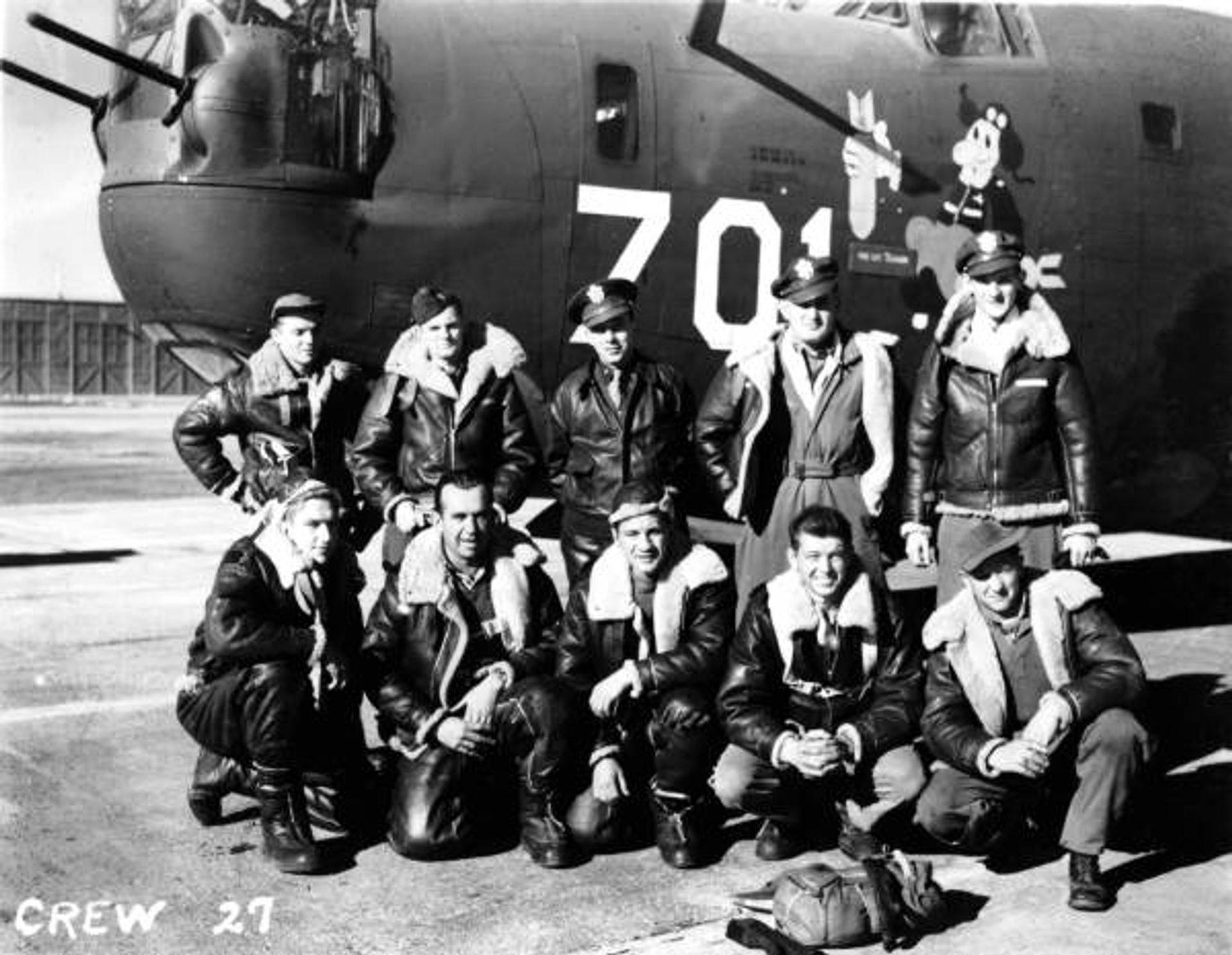
First crew (tied) to Complete Combat Tour
| Rank | Name | Serial # | Pos | Date | Status | Comments |
|---|---|---|---|---|---|---|
| 1Lt | Jack K Umphrey | 0797643 | Pilot | 13-Jun-44 | CT | Awards - Distinguished Flying Cross |
| 2Lt | James W Bryan | 0886820 | Co-pilot | 13-Jun-44 | CT | Awards - Distinguished Flying Cross |
| 2Lt | Lawrence G Shapiro | 0741758 | Navigator | 13-Jun-44 | CT | Awards - Distinguished Flying Cross |
| 1Lt | Harold B Hall | 0752850 | Bombardier | 13-Jun-44 | CT | Awards - Distinguished Flying Cross |
| T/Sgt | Robert L Long | 33389875 | Radio Operator | 25-Oct-44 | CT | Relv from attatch to 60SC |
| T/Sgt | Joseph P Whitecavage | 13025191 | Flight Engineer | 06-Jul-44 | CT | Reld from aerial flights |
| S/Sgt | Gus D Sasinowski | 32832182 | Armorer-Gunner | 06-Jul-44 | CT | Reld from aerial flights |
| S/Sgt | Frank T Kinker | 33525487 | Armorer-Gunner | 13-Jun-44 | CT | Awards - Distinguished Flying Cross |
| S/Sgt | Percel A Korelewski | 17157078 | Armorer-Gunner | 13-Jun-44 | CT | Awards - Distinguished Flying Cross |
| S/Sgt | Ernest W Gordon | 14057221 | Armorer-Gunner | 13-Jun-44 | CT | Awards - Distinguished Flying Cross |
Crew 27 trained with the 458th at Tonopah, Nevada during the last part of 1943. They moved to the ETO in January 1944. The crew underwent several changes at some point after their crew photo was taken in November 1943. Other than their surname listed on the crew photo, Sgt’s Edward V. Kersheske and Felix P. Turkovitz do not appear further in 458th records, but they do appear on a group roster in the 2nd Air Division files in May 1945. These men were replaced by Sgt Gordon (from 752nd Squadron) and Sgt Sasinowski. Replacing navigator 2Lt Joseph J. Zagone, who was transferred to the 470BG at Mountain Home, ID on December 29, 1943, was Lt Lawrence Shapiro. Records do show Pfc Clair W. Lantzy 13089708, as an Airplane & Engine Mechanic in the 753rd Squadron in April 1944 through April 1945. His place as Flight Engineer was taken by Sgt. Whitecavage. It is most likely that these changes took place prior to movement overseas.
Crew 27 flew both diversion missions in late February and flew the group’s first combat mission to Frankfurt on March 2, 1944. Their total of nine missions in March would include trips to Berlin, Friedrichshafen, Brunswick, and Osnabruck as well as several targets in occupied France.
By April 19th the crew had completed 15 missions, all but one flown in a B-24H named Flak Magnet. The crew was sent on rest home leave on April 20th and Flak Magnet was lost two days later on the Hamm raid while being flown by Lt. George Spaven and crew. Upon their return from leave the crew took over another B-24, one of the first unpainted B-24H’s to arrive as a replacement aircraft. They named it Flak Magnet II flying it on five missions in May, including one recall. This aircraft was eventually transferred to the 467th BG, where it was lost in an accident.
From May 4th to May 31st, the 458th flew 21 missions, and Crew 27 flew the remaining 15 mission of their required 30. They were tied (with another 753rd crew, #28, pilot Lt Samuel Robeson) for the first crew to complete a combat tour with the 458th. Making this all the more remarkable is the fact that they flew all 30 missions without having to turn back once due to mechanical or personnel failure. The crew had to use three aircraft on one day to accomplish this feat (see below). For this particular action, Lt Umphrey was awarded the DFC.
On the May 19th mission to Brunswick, Sgt Frank Kinker was credited with an enemy aircraft destroyed. While the details are not given in the 458th’s records, it is noted that he received the Distinguished Flying Cross on June 13th, 1944 and an Oak Leaf Cluster to this DFC for the enemy aircraft that he shot down.
On May 26, 1944 the crew was transferred to the 752nd Squadron and flew with them for their final three missions. The reason for this move is not recorded, but ten AZON crews had arrived on May 26th and were assigned to the 753rd Squadron. It is possible that Umphrey and crew were sent to the 752nd to make room for these new crews coming in.
The entire crew were awarded the Distinguished Flying Cross in June.
Missions
| Date | Target | 458th Msn | Pilot Msn | Serial | RCL | Sqdn | A/C Msn | A/C Name | Comments |
|---|---|---|---|---|---|---|---|---|---|
| 24-Feb-44 | DUTCH COAST | D1 | -- | 41-28733 | -- | J4 | D1 | RHAPSODY IN JUNK | Diversion Mission |
| 25-Feb-44 | DUTCH COAST | D2 | -- | 41-29273 | -- | J4 | D2 | FLAK MAGNET | Diversion Mission |
| 02-Mar-44 | FRANKFURT | 1 | 1 | 41-29273 | Q | J4 | 1 | FLAK MAGNET | |
| 03-Mar-44 | BERLIN | 2 | 2 | 41-29273 | -- | J4 | 2 | FLAK MAGNET | |
| 06-Mar-44 | BERLIN/ERKNER | 4 | 3 | 41-29273 | Q | J4 | 3 | FLAK MAGNET | |
| 09-Mar-44 | BRANDENBURG | 6 | 4 | 41-29273 | Q | J4 | 4 | FLAK MAGNET | |
| 16-Mar-44 | FRIEDRICHSHAFEN | 8 | 5 | 41-29300 | M | J4 | 6 | LORELEI | |
| 23-Mar-44 | OSNABRUCK | 12 | 6 | 41-29273 | Q | J4 | 8 | FLAK MAGNET | |
| 24-Mar-44 | ST. DIZIER | 13 | 7 | 41-29273 | Q | J4 | 9 | FLAK MAGNET | |
| 26-Mar-44 | BONNIERES | 14 | 8 | 41-29273 | Q | J4 | 10 | FLAK MAGNET | |
| 27-Mar-44 | BIARRITZ | 15 | 9 | 41-29273 | -- | J4 | 11 | FLAK MAGNET | |
| 08-Apr-44 | BRUNSWICK/WAGGUM | 17 | 10 | 41-29273 | Q | J4 | 13 | FLAK MAGNET | |
| 09-Apr-44 | TUTOW A/F | 18 | 11 | 41-29273 | Q | J4 | 14 | FLAK MAGNET | |
| 10-Apr-44 | BOURGES A/F | 19 | 12 | 41-29273 | Q | J4 | 15 | FLAK MAGNET | |
| 12-Apr-44 | OSCHERSLEBEN | REC | -- | 41-29273 | Q | J4 | -- | FLAK MAGNET | RECALL |
| 13-Apr-44 | LECHFELD A/F | 21 | 13 | 41-29273 | Q | J4 | 17 | FLAK MAGNET | |
| 18-Apr-44 | BRANDENBURG | 22 | 14 | 41-29273 | Q | J4 | 18 | FLAK MAGNET | |
| 19-Apr-44 | PADERBORN A/F | 23 | 15 | 41-29273 | Q | J4 | 19 | FLAK MAGNET | |
| 04-May-44 | BRUNSWICK/WAGGUM | 34 | 16 | 42-50320 | J | J4 | 5 | UNKNOWN 018 | |
| 05-May-44 | SOTTEVAST | 35 | 17 | 42-50320 | J | J4 | 6 | UNKNOWN 018 | |
| 07-May-44 | OSNABRUCK | 36 | 18 | 41-28962 | N | J4 | 1 | FLAK MAGNET II | |
| 08-May-44 | BRUNSWICK | 37 | 19 | 41-28962 | N | J4 | 2 | FLAK MAGNET II | |
| 09-May-44 | ST. TROND | 38 | 20 | 41-28962 | N | J4 | 3 | FLAK MAGNET II | |
| 10-May-44 | DIEPHOLZ | REC | -- | 41-28962 | N | J4 | -- | FLAK MAGNET II | RECALL BEFORE EC |
| 11-May-44 | EPINAL | 39 | 21 | 41-28962 | N | J4 | 4 | FLAK MAGNET II | M/F SHIP |
| 12-May-44 | BOHLEN | 40 | 22 | 42-95183 | O | J4 | 2 | BRINEY MARLIN | |
| 19-May-44 | BRUNSWICK | 42 | 23 | 41-29489 | I | J4 | 3 | UNKNOWN 014 | |
| 20-May-44 | RHEIMS A/D | 43 | 24 | 41-29489 | I | J4 | 4 | UNKNOWN 014 | |
| 21-May-44 | SIRACOURT | 44 | 25 | 41-29489 | I | J4 | 5 | UNKNOWN 014 | |
| 23-May-44 | BOURGES | 45 | 26 | 41-28962 | N | 7V | 5 | FLAK MAGNET II | |
| 24-May-44 | VILLEROCHE | 46 | 27 | 42-95117 | M | 7V | 8 | YOU CAN'T TAKE IT WITH YOU | |
| 29-May-44 | TUTOW A/F | 50 | 28 | 42-50279 | T | Z5 | 15 | ENVY OF 'EM ALL | TOOK OFF IN 3 B-24's |
| 30-May-44 | ZWISCHENAHN A/F | 51 | 29 | 42-95219 | W | 7V | 8 | PATCHIE | |
| 31-May-44 | BERTRIX | 52 | 30 | 42-95219 | W | 7V | 9 | PATCHIE | 1ST CREW 30 MSN |
B-24H-10-CF 41-29273 J4 Q Flak Magnet

“Our airplane was the Flak Magnet that we picked up at Hamilton Field and flew to the UK via the southern route. We had the nose art painted by a GI at Homestead AAB in Florida before leaping off from the US. I can still remember sitting on the ramp in the shade of the wing trying to come up with a name. We had already decided to have the P-40 “shark” nose painted on, but couldn’t come up with a name to go with it. Some of the pilots were naming their plane after wives or sweethearts, but I didn’t think that was fair. As you can see, we never were able to find a name that went with the art. And our nose art, far from looking like a vicious shark, more resembled a friendly whale lumbering down the runway. We took a lot of kidding about it!”
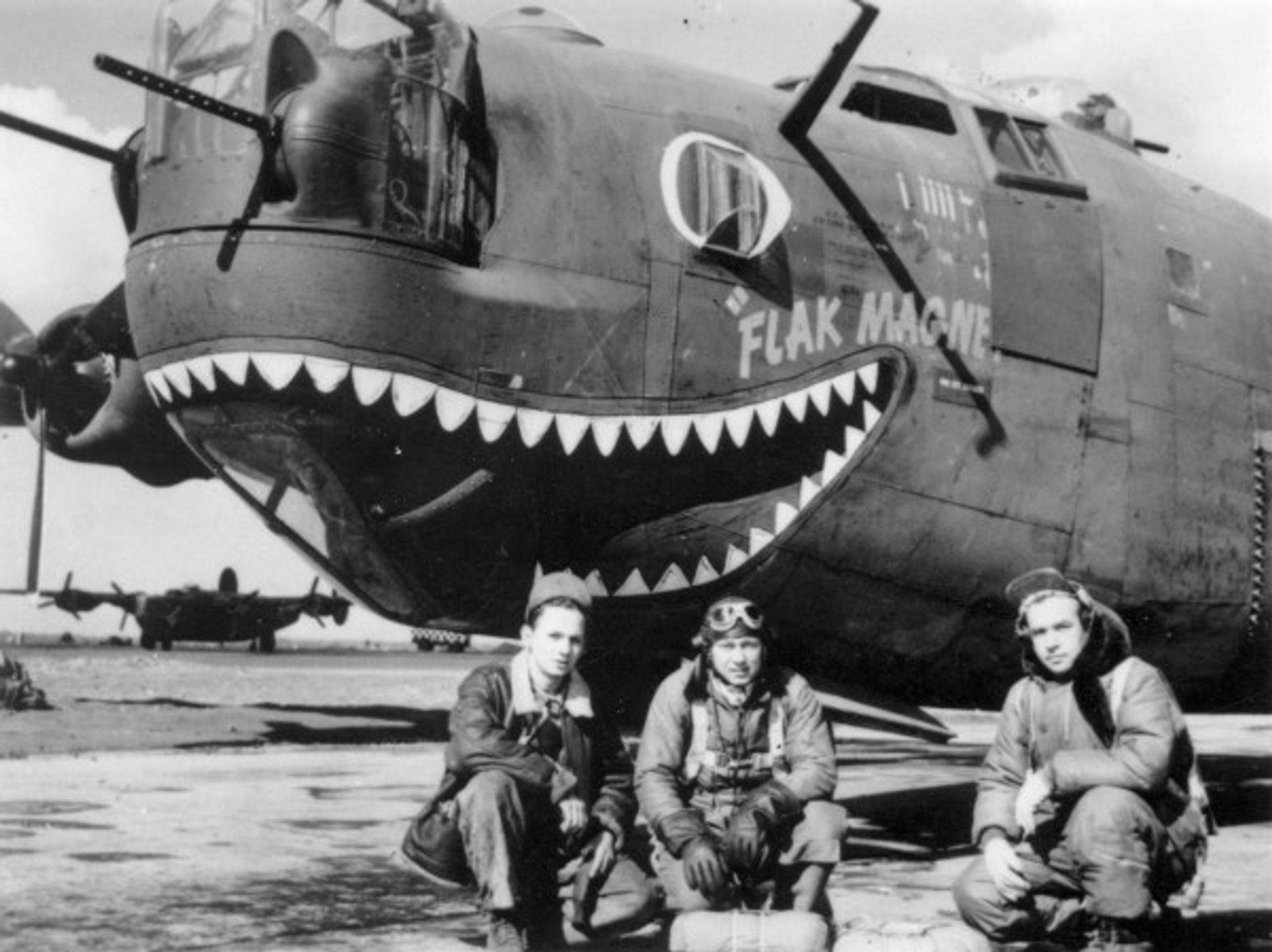
“The big reason we were able to finish so quickly was that I was in Ops every day wanting to fly tomorrow. We all wanted to get it done and go back home. Plus, we didn’t want anyone else to fly our airplane! We were ordered to take ten days leave after fifteen missions and the Flak Magnet was shot down [on April 22nd – Crew 33, Lt. Spaven] while we were gone – mixed emotions about that; would we have been on it vs. it wouldn’t have happened if we had been on it.
We got a silver B-24J replacement about ten days later and had the same nose art put on and named it Flak Magnet II, but we never felt the same about it as we did the original. Don’t know what happened to that one. It was still flying when we left.”
Sgt Robert Long, radio operator (right) – early March 1944
Painting & Photo: Mike Bailey
A Determined Crew: Stars & Stripes Articles
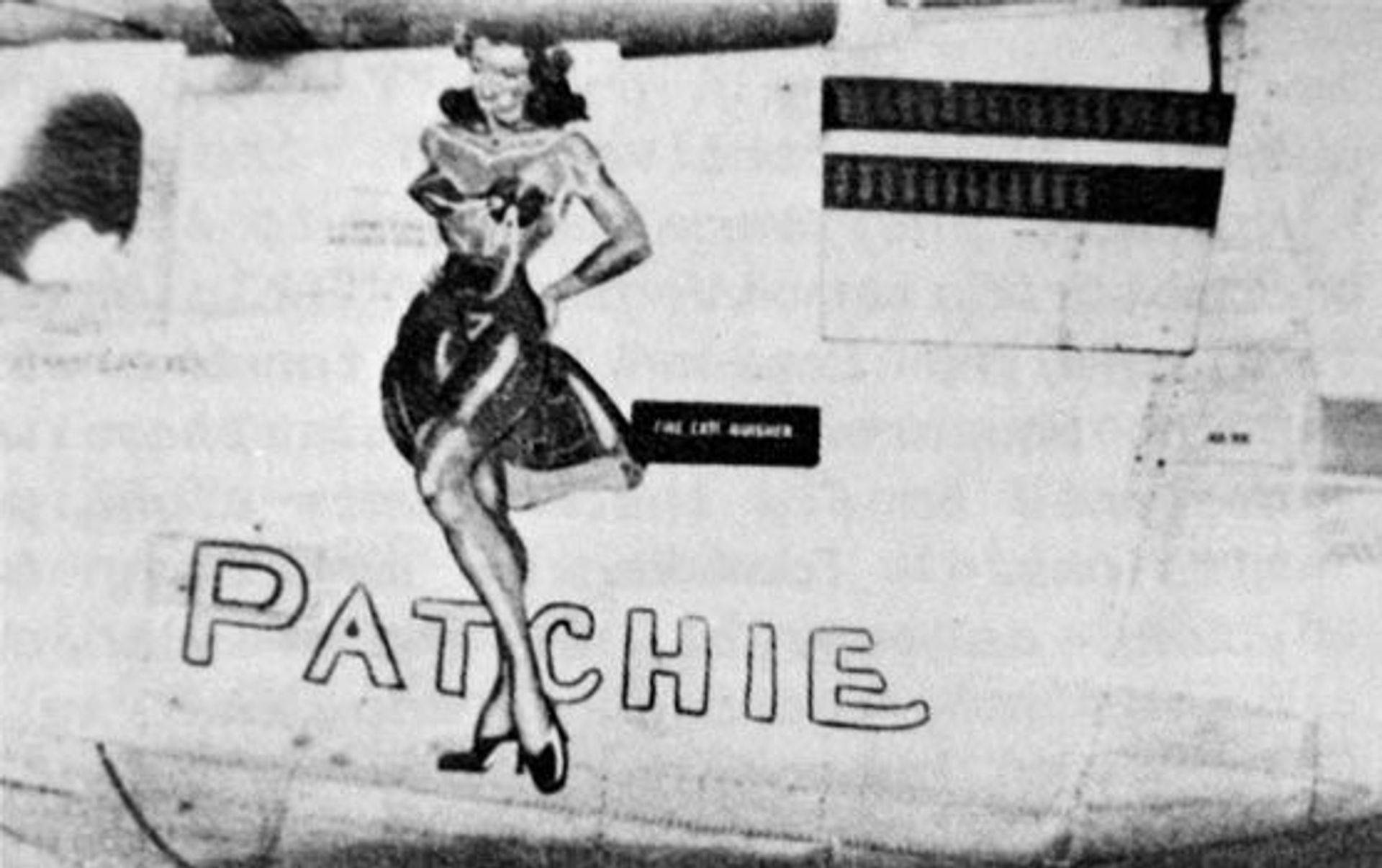
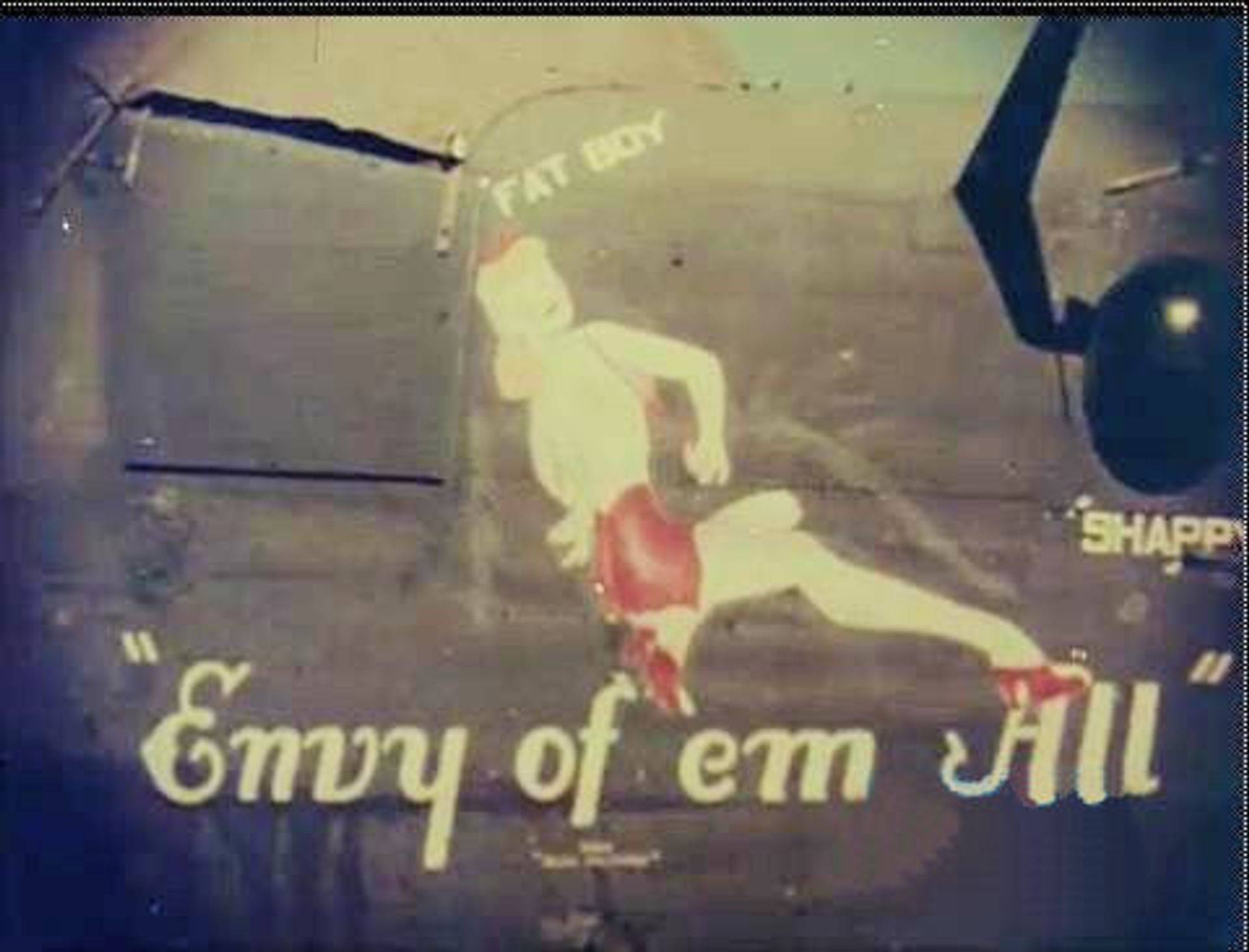
The crew’s first aircraft on May 29th, Patchie, and their third, Envy of em All
(Photos: Brendan Wood)
3 Planes Late, a Lib Catches Up Over Reich
A Liberator Base. May 29 – 1/Lt. Jack Umphrey, Birmingham (Ala.) pilot, and his crew started out with the rest of the group for Politz, German this morning. At 4,000 feet their Liberator developed a hydraulics leak and they went back to base.
Scrambling out of their ship, the crew boarded another plane, took it down the runway and then discovered it was not ready for operational flying. They taxied back to the dispersal area and got their third plane of the day.
Umphrey took the B-24 off under full boost, [and] pushed the throttles on the course his group had taken. All alone, he and his crew flew out to the Continent until, one hour and 40 minutes late, they caught up with their own formation over Germany and went on to bomb the target and come home.
Crew Uses 3 Bombers To Participate in Raid
London, AP – Lieutenant Jack Umphrey, of Birmingham, Ala. And his crew ran their string of completed bombing missions to 28 yesterday, although it took three Liberators to do it.
Shortly after takeoff, they discovered a leak in the hydraulic system of their original Liberator. Returning to the base, they piled into another and were taxiing away when they found it was not equipped to fight.
Determined to keep their records intact, they climbed into a third ship and again took off, despite the fact that their sister ships by then led them by an hour and 40 minutes. They flew into Germany all alone – luckily meeting no enemy fighters – and joined up with a Liberator group to help in the bombing. 5/31/44
[Lt Umphrey received the Distinguished Flying Cross for his performance on this day]
Stars & Stripes Articles courtesy Jack Umphrey
B-24H-25-FO 42-95050 7V J Gas House Mouse

Crew 27 & Crew 28 are First to Complete Combat Tour
NECK AND NECK
There had been some speculation on just what crew or crews, would break the tape first on their operational tour, but the final honors were bestowed on LT. SAMUEL ROBESON of the 753rd Sq., and LT JACK UMPHREY of the 752nd Sq., and a number of their original crews who started as a team back in the States.
However, the honor of being the first combat member of the group to finish first, went to S/Sgt Robert L. King. A member of Lt. Robeson’s crew. Sgt. King gained this honor by filling in as a spare gunner on another crew when his A/C was non-operational on one mission.
The groups’ first mission was flown on March 2, and in exactly 98 days, these two crews had completed 30 missions each over Germany and occupied territory, finishing their tours on 31 May 44. It is an undisputed fact, that those first missions during March and April were the toughest flown by the group, and, it is to the credit of the leadership shown by these officers, that not one of the men who flew with them were wounded in action though they had undergone some of the fiercest enemy fighter opposition and had taken all the flak Jerry could throw at them.
To add further laurels to those already bestowed on them, not once in 30 missions did Lt. Umphrey abort, and but three abortions mar Lt. Robeson’s record, and those for mechanical rather than personnel failures.
To tell of their experiences would take ages, but one cannot forget the morning of May 29. Lt. Umphrey took off this morning, but shortly after take-off his A/C developed a hydraulic leak and he was forced to return to base. He transferred with his crew to another A/C and taxied to the runway, only to be informed that the plane was not ready for operational flight. After taxiing back to the dispersal area, he transferred to a third liberator and took off one hour and forty minutes later than his formation, crossed the north sea alone, and caught up with a formation forty miles inside of Germany and proceeded to bomb the assigned target.
Then when “Pop” (as Lt. Robeson is known to his crew), brought the boys home on two engines after a deep penetration into Germany. “Pop” was forced to leave the formation after being hit by flak knocking out two engines. During the long solitary journey home, he was beset upon by a German fighter but managed to scare him off. The new co-pilot advised bailing out or landing in Switzerland, but “Pop” knew his plane and quietly said, “Stay put, I’ll get you back”, and his crew, knowing “Pop” always kept his word, worried no more.
Talking to these men, one does not gather an impression of boastfulness or bravery, they simply state “We had a job to do, we were trained for it, we knew how to do it, and we just did it”. How the hell can you lose with men like that?
The following named men head the roll of honor as the first combat members of the group to finish their tour with an outstanding record and an inspiration to those who follow.
753rd sq. 752nd sq.
1st Lt Samuel C. Robeson 1stLt Jack K. Umphrey
1st Lt George R. Heiser 2nd Lt James W. Bryan
1st Lt J. B. Welch 1st Lt Lawrence G. Shapiro
T/Sgt Joseph M. Fleenor S/Sgt Gus A. Sasinowski
S/Sgt Marvin M. Morrow S/Sgt Percel A. Koroleski
S/Sgt Joseph C. Bowman
S/Sgt Robert L. King
Excerpt from 753rd Squadron records
Distinguished Flying Cross
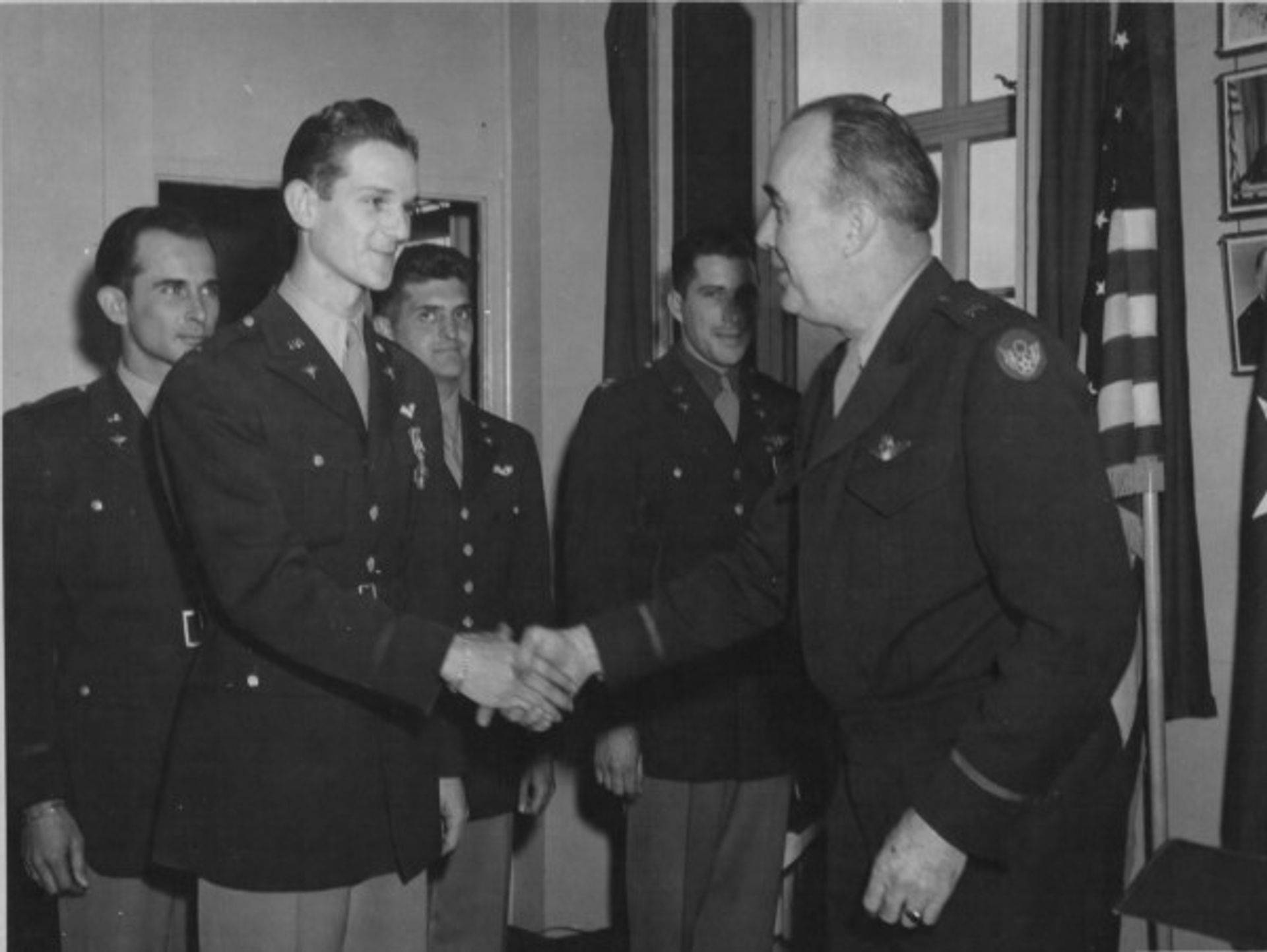
(L-R): Lt’s. Stephen Davidson, Jack Umphrey, Robert Nixon, Capt. Carl Marcussen (392BG), and BGen Walter Peck
Photo: FOLD3
GO No. 95, Hq 2BD
13 June 1944
JACK K. UMPHREY, 0-797643, First Lieutenant, Army Air Forces, United States Army. For extraordinary achievement while serving as Pilot of a B-24 aircraft on a bombing mission to Germany, 29 May 1944. Lieutenant Unphrey’s aircraft developed a hydraulic malfunction, shortly after being airborne, necessitating a return to base. Transferring to a second aircraft, Lieutenant Umphrey taxied to the runway ready to take off when he was informed that the aircraft was non-operational. Determined to fly this deep penetration, Lieutenant Umphrey boarded a third B-24 and, though on hour and forty minutes late, succeeded in catching the formation forty miles inside the German border, continuing on to bomb the primary target. The devotion to duty, determination, and skill displayed by Lieutenant Umphrey on this occasion reflect the highest credit upon himself and the Armed Forces of the United States. Entered military service from Alabama.
S/Sgt Ernest Gordon – Tour of Duty
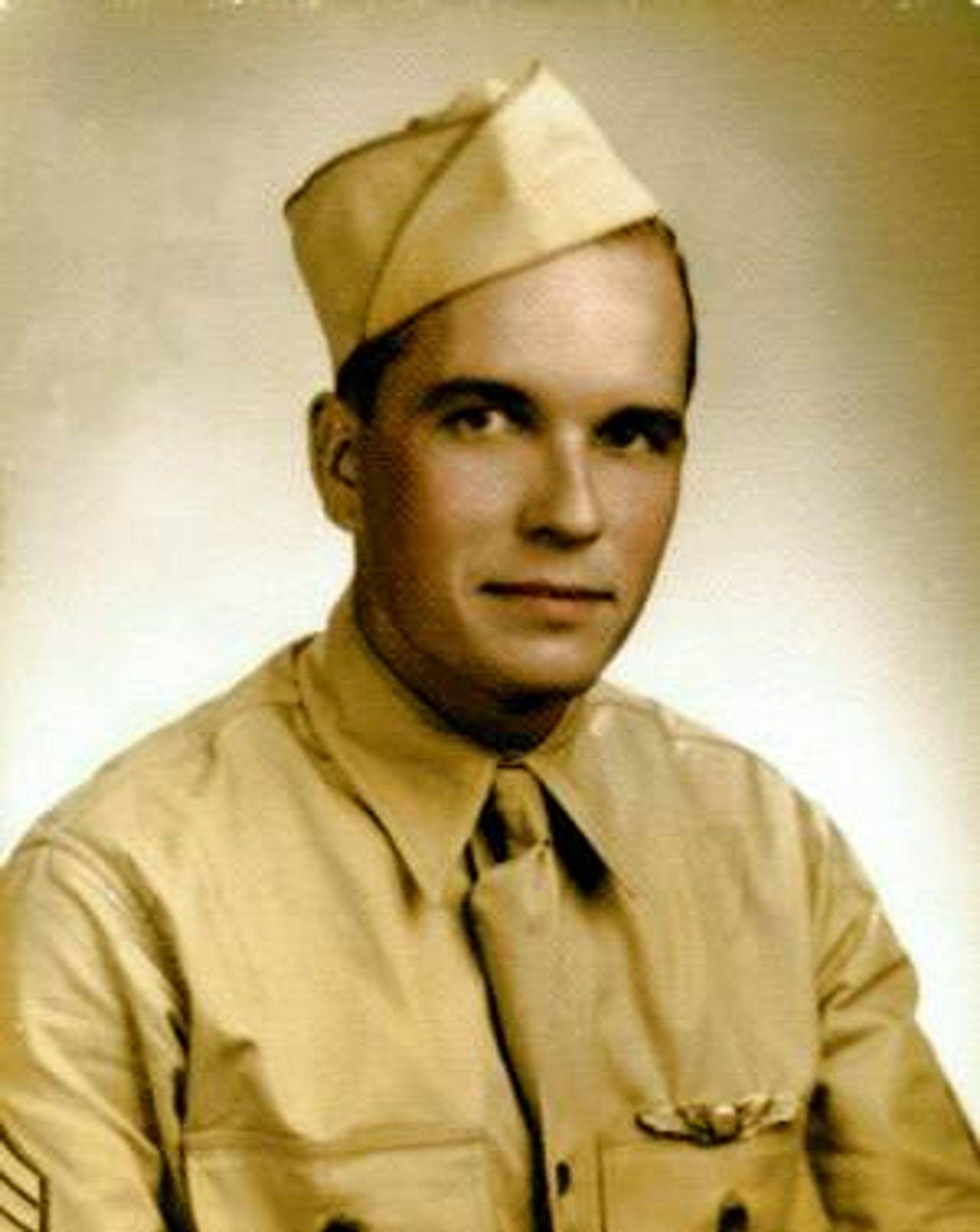
Having been encouraged to do so I offer the following account of World War from my perspective. First, my memory has faded as last year’s bright colors fade in the wash after a while. While in Service we were told not to keep a diary or take pictures for fear such might conceivably fall into the hands of the enemy. I found out later many people were not so impressed. I will pick up from January 1944 when I left West Palm Beach, Florida. I was unceremoniously “bumped” from the flight of the Flak Magnet on it’s way overseas by a ranking official. It made me feel I had been on “standby”. Soon after my crew took off on its Southern Route trip via Brazil and North Africa I was routed north as a passenger, with several others, with the Ferry Command. This trip was an insult: They flew me over on a B-17!!!
After a refueling stop at Presque Isle, Maine we landed at Goose Bay, Labrador. We spent two nights, two days before taking off about midnight the third night for Scotland. We landed at Prestwick about three P.M. We were given some funny British money and a train ticket to Norwich where a truck was waiting to take us to Horsham-St. Faith air base. The base had been used as a RAF facility with 2 story brick barracks and paved streets. There I stood, a gun in one hand and a knife in the other; I didn’t know whether to shoot up the street or cut across the alley–naw, that’s from another story. The truck put me out amongst these four buildings, and they told me I could select the living quarters for me and my crew. Limit, two rooms. I selected them upstairs; a small one for me and one other. It turned out he was the tail-gunner, Sasinowski. The other four shared a larger room. Each had its own fireplace and we were to share the bath which was in between the rooms.
The rest of my crew showed up a week later. THEN they turned the hot water on in the building. Bathing and shaving in cold water was a brand new experience for me. Each room was issued a small amount of coal and coke which meant we had to make “moonlight requisition” trips to the one big coal pile. Each room had blackout screens we had to fasten over the windows at night to prevent light from escaping. Jerry might see it!
We survived the war because above everything else our pilots were taught was close formation flying. That was stressed. Our pilots were the best at close flying I saw. Our co-pilot was so good at it we normally flew off left wing of the leader of the formation. Would you believe over-lap? He still had time to sign with the other plane’s pilot. Was that close? Now, before our actual tour of duty began we flew two decoy (duck) trips out over the North Sea as part of our training, also to try to fool Jerry into thinking we [were] the actual invading force. On those missions I flew up in the nose turret. I didn’t like it up there and was glad when the Powers that were decided the bombardier need to have that spot. What follows is a list of the missions I was on with some comments on some.
Mar 2 –Frankfurt (Gr) Time: 6 hrs, 40 min. loaded with 52 70 lb incendiaries. Formation was attacked by 4 FW-190’s. One ship crash-landed at home base. 7 died. [Lt Gorrell 752BS – crashed on takeoff]
Mar 3 –Berlin. Time: 6 & 30. First 8th AF raid there, loaded with 52 70lb incendiaries. 27 A/C went – lost 5. Heavy clouds, results poor. Also Potsdam was hit. I suffered frostbite from the 60 below temp. in my cheeks and was grounded for a while. [This could be in reference to March 6th, when the 458th lost five aircraft and crews. March 3rd was to Berlin, but was recalled due to weather, Lt Herzik and crew in the 755th, was lost to unknown circumstances. Crews did receive mission credit.]
Mar 16 — Friederickshafen (Mangell) (Gr) Time 8 & 35. We carried 52 70lb bombs. Undercast solid to broken. Results unobserved. One plane ditched in the Channel returning, one died. [Lt Peters 755BS] Some of the thickest flak I had seen.
Mar 23 –Osnabruck (Gr) Time : 6 hrs. Loaded with 10 500 lb demolition bombs. 25 A/C went out; 24 returned. Lost over Munster. [Lt Hetzler 752BS]
Mar 24 –St. Dizier (Fr). Time 7 & 15 we carried 240 20lb fragmentation bombs we dropped on a German flying school. 22 A/C attracted no enemy A/C, flak was light. 13 ships had minor damage. No losses.
Mar 26 –Bonniers (Fr) Time: 4 & 40. Carried 10 500lb demos. 27 A/C on sortie. Lead navigator’s error resulted in returning with the bombs.
Mar 27 –St. Biarritz (Fr), near Spanish border. Time: 8 & 10, loaded with 240 20lb frag. bombs. I and Frank Kinker pioneered as bombardiers (as related in an accompanying story). 24 A/C took part -all returned, and none damaged.
During March the group lost 12 planes (120 men). 5 crewmen KIA and 105 MIAs.
——————-
April 8 –Brunswich-Waggum (Gr) Time: 7 hrs. Loaded with 40 clusters of 20 lb fragmentation bombs. 36 A/C hit airfield and nearby factories. Had strong fighter opposition. Our gunners shot down 9 of theirs and 5 others were damaged. We lost 1 Lib. I saw it go down, spiraling nose down. Every time the ship would level out momentarily a couple of men would [bail] out. [Lt Sievers 753BS]
April 9 –Tutow (Gr) (Easter Sunday) Time: 8 & 05. We carried 10 500lb demo’s. 19 A/C to hit FW-190 factory; 12 made that attack. Weather forced 7 to hit Parchion airfield and V-2 rocket factory. Was I scared? It was just that all of a sudden I felt that my experience as a dishwasher could be more useful to the Service, but when I voiced my concerns to Jack Umphrey he nixed the idea. Shot to Hell! I thought the world loved a volunteer. One time on our return to East Anglia I asked him for permission to jump, and you know what–he nixed that also. Jack was like that.
April 10 –Bourges (Fr) Time: 6 & 35. Loaded with 6 10001b demo’s we were to bomb aircraft factory. Lead ship accidentally salvoed his load too early; other ships followed suit, but with excellent results. Anyway no flak nor enemy A/C. All returned with no damage.
April 13 –Augsburg (Lechfeld) (Gr) Time: 7 & 55. Loaded with 10 500lb demos. Hit airfield 30 miles west of Munich site of a bombed school, night flying school training pilots to fly the then new ME-410 night intruder fighters. All but 10 bombs fell within 2000 ft. of target. Many direct hits.
April 19 –Paderborn (Gr) Time: 5 & 35. Load: 40 100lb demos carried by 24 ships led by General Peck and [Colonel] Isbell. All ships returned; two with minor damage. I would have felt much safer if I had known a general was in the lead plane. They don’t shoot at generals, do they?
During April 8 A/C were lost to enemy action. Our crew at this time was ordered to take a 10 day furlough. To escape torture we accepted. It was during this time, the 22nd, that our ship. Flak Magnet, was shot down. [Lt Spaven 753BS]
————————
May 4 –Brunswick-Waggum (Gr) Time: 5hrs. Load was 8 10001b demos. Here is the first major conflict among my record, the record the 2nd ADA pub–
May 5 –No-ball mission to who knows where. Time: 6 hrs. 19 ships took part. I must have flown with another crew. My pilot’s log doesn’t include May 5. I couldn’t have gone alone. I’ll fall back on the faded memory bit.
May 7 –Osnabruck ( Oschersleben ) (Gr). Time: 5 & 30 We carried 12 500lb demos. Bombed by PFF (radar) through thick undercast. 5 Libs received minor damage.
May 8 –Brunswick (Gr). Time: 6 hrs. We dropped 12 500lb demos on Waggurn airfield and nearby factories by PFF. 87 German A/C felt offended by our intrusion. Squadrons 752 & 753 each claimed two of the 87.
May 9 –St. Trond (Fr) Time: 5 & 10 25 A/C each carried 40 100lb demos and bombed hangers and disposal areas.
May 11 –Epinal (Fr). Time: 5 hrs. 29 A/C carried 5 10001b demos, bombed marshalling yards. One Lib had to go to Switzerland [Lt Goldsmith 754BS]
May 12 –Bolen (Gr). Time: 8 & 15. 40 100lb demos carried by each of 25 ships to hit synthetic oil factory 8 miles south of Leipzig. Made some direct hits. Two of our ships sustained minor damage.
May 19 –Brunswick (Waggum) (Gr). Time: 7 hrs. 21 A/C each carried 5 10001b demos, hitting factories near Waggum airfield. Our [gunners] shot down one enemy plane.
May 20 –Reims (Fr). Time: 5 & 30. 24 ships loaded with 8 1000lb demos each hit an airfield. Flak was meager, no enemy aircraft was seen.
May 21 –Siracourt (Rheims) (Fr). Time: 5 & 30. 24 ships each loaded with 40 100lb demos went on this one. Minor damage.
May 23 –Bourges (Fr). Time: 6 &. 45. 29 A/C started out, each with 40 100lb demos. A B-17 collided with one of ours over Eye, Suffolk. We lost 6 crewmen killed. [Actually the entire 10 man crew of Lt. Barton in the 754th BS were killed.]
May 24 –Melon-Villaroche (Fr). Time: 5 & 45. 21 ships each carried 52 70lb incendiaries. Airfield was hit with excellent results. No enemy A/C.
May 29 –Tutow (Gr). Time: 8 hrs. 25 A/C , each carrying 12 500 demos hit factory and installations. Our crew tried out the third plane before
we found one that would take us there and bring us back. An account written by Jack Umphrey covers this story. His crew watched him get his first Distinguished Flying Cross pinned on his chest.
May 30 –Leipzig (Zwischenahn, Gr.) Time: 5 & 40. 24 ships each carrying 12 500lb demos hit airfield & testing base for new jet fighter. Good results. No enemy A/C.
May 31 –Bertrix (Belg.) Time: 4 & 20. Load was 3 2000lb demos. Target was locomotive and marshalling yards. Group recalled while over Belgium because of a mysterious black B-24 with its nose and top turrets painted black. We still got credit for a completed mission.
June 2 –Stella Plage (Fr). Time: 4 & 40. We each carried 7 l000lb demos. It was a no-ball mission in the Pas De Calais area. V-1 installations.
June 4 –Bourges (Fr). Time: 6 & 35. My last mission! Most of my crew had finished earlier. Remember, I was out for a while because of frostbite. I have no other record other than the crew I flew with had to land at a RAF base on our return because our base was socked in with fog. We had to endure RAF hospitality that night, complete with horse-hair blankets, although their food was tolerable it wasn’t what I was accustomed to eating. Then it occurred to me why the RAF fighters were so ferocious; they were mad as hell from sleeping under those horse blankets. After we took off on our way back to Horsham-St.Faith we were challenged by the RAF fighters, and would you know, the aircraft commander didn’t have the correct ID code so they followed us to our base. After alighting at our base, and kissed the ground, I learned the powers that were had a welcome mat for me: I was assigned to anti-aircraft bunker that night as well as several nights more. They wanted the welcome to be memorable.
The group lost 2 ships to enemy action during May.
——————————
ACKNOWLEDGEMENTS
I am indebted to the Grace of God through the prayers of my family, my wife and her family; the leadership of our ship’s captain, Jack Umphrey, who was always calm, cool, and collected; the laid-back skills of co-pilot Bacon Jim Bryan (He was the best co-pilot in the group); the unsurpassed skills of our bombardier Byron Hall, navigator Lawrence Shapiro; and the skills of the rest of my crew: Frank Kinker left waist gunner, Percy Korolewski ball turret gunner, Robert Long radio operator, Joe Whitecavage engineer & cop turret gunner, and Gus Sasinowski tail gunner.
Part of the info given here came from a 458th Bomb Group publication.
—————————–
AFTER THE 30
When I landed at Horsham St.Faith following my last mission I thought I could kiss the ground, congratulate myself and start packing to go home. After all, I was a “Happy Warrior” and they get sent home. Don’t they? No, the powers that were, in their infinite wisdom, decided I could still serve the war effort in another capacity. Orders were cut detailing me to Northern Ireland to teach in a gunnery school. They didn’t even ask if I had any teaching experience. The order specified “you will”. I didn’t argue. Democracy was not practiced in the Service at that time.
The job consisted of giving new replacement flying personnel a refresher course in what they learned at gunnery school. The whole thing was boring, the subject they gave me to cover was the most boring: Nomenclature. I had to go over the names of the different parts of the Browning 50 caliber machine gun. I enjoyed about three months of Northern Ireland’s country life teaching a new class every 30 minutes. I don’t remember how many I had each day, but there were plenty.
Then I was sent back to England but not to East Anglia. I thought; “Now, I’m going home”. No again! Word must have gotten out about me volunteering for K.P. duty, because that is what I did for the next 2 or 3 months. I soon learned a S/Sgt can still wash pots & pans. The lowest rank on that field at that time was Sgt. T/Sgt’s and M/Sgt’s pulled guard duty. Unhappy “Happy Warriors”, all. I’m glad I was already on the Ile De France in Glasgow harbor when the Battle of the Bulge happened or they would have found a place there for me. I sure learned the meaning of “versatile”. I had best stop before I put you to sleep.
Ernest Gordon
———————————
BOMBARDIER FOR A DAY
With apologies to Ed Wanner (445th) for one-upping him…
27 March, 1944: This was my 7th mission (a term later changed to “Sortie”). Sortie had a “limey” flavor to it, I thought). My crew made our way into the briefing room where all the crews in our squadron scheduled to fly that day were either already there or like us were making it in. After we were all seated the man with the pointer in his hand displayed our target. I must have joined everyone else in giving a sigh of relief because the red ribbon pointed south to Southern France just before it became Spain, specifically to a town called Biarritz. The man in charge told us we would be helping a graduating class of German pilots celebrate. He reckoned the ceremonies should be under way before the first bomb hit. What prompted the sighs, of course, was we knew flak would be scarce over water and since the school was on the coast we could drop and soon be over water again returning to base.
While we [were] preparing to board, Frank Kinker the left waist gunner and I, right waist thought it would probably help the war effort if we each took one of the frag bombs we were delivering and drop them out the waist window. It would help the cause. Every little bit helps, that sort of thing. We knew enough not to let any of the commissioned officers know lest Jack Umphrey, our pilot, would take a dim view of our plan. When we were making the bomb run to the school building at 10 thou (or was it 5?) Frank and I calculated the trajectory and time it would take to hit the building. Being the highly trained bombardiers that we were (we had been to gunnery school), we pulled the pins and dropped those suckers out the windows. We went that extra mile. Of course we had developed a strong dislike for Hitler and his men, and Tojo was waiting.
Back at base during debriefing the man in charge called out: “Will Sgt’s Kinker and Gordon please stand?” We arose, me thinking what did they catch me doing now, and Kinker. The man said he just wanted to show us what our individual bombs did. He said it was believed my bomb was the one that strayed a hundred yards or so and made a direct hit in the cockpit area of a JU-88 that was parked on the apron in front of the building. All right! It’s my story; I’ll tell it my way. The fad soon caught on to the extent that orders soon went out that no more bombs that a man could carry into the aircraft be left near the planes. I was so relieved there was no penalty involved I did not claim credit for the “kill”. I have always wondered just how the man up front learned about our bombing. I didn’t tell.
Ernest Gordon’s memoirs and photograph appear here courtesy of his son Ken Gordon and nephew Larry Weathersby
